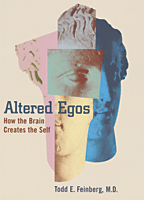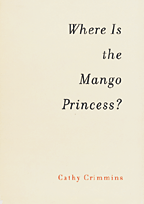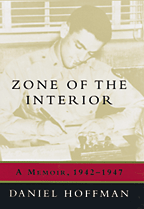A riveting tour of what can go wrong with the brain.
By Cathy Crimmins

ALTERED
EGOS:
How the Brain Creates the Self
By Todd
E. Feinberg C’74
New
York: Oxford University Press, 2000. 224
pp., $25.00.
Order
this book
Why do
we humans find it so difficult to think about our brains? In Altered
Egos: How the Brain Creates the Self, Todd Feinberg C’74 explores
this eternal paradox. The one aspect that distinguishes us from lower
animals—our ability to create a self and indulge in abstract thinking—is
nearly impossible for human scholars to decipher or explain. Yes, the
brain is an organ, but not an organ we feel.
We do not perceive
ourselves thinking the way we feel our hearts beating, or our lungs
filling with air. And the work of the brain goes far beyond just regulating
our other major organs and our ability to move, see, hear, smell and
speak. Our most important organ also determines who we will be in the
context of our community and families. Our soul, or sense of self, is
contained in the four-pound blob of gray matter that rests inside our
skulls.
In his well-written
study, Feinberg, a neurologist and psychiatrist at Beth Israel Medical
Center in New York, takes us on a riveting tour of what can go wrong
with the brain, and what those errors tell us about the cerebral nature
of being human. He has examined hundreds of patients with Alzheimer’s
disease, epilepsy, traumatic brain injury (TBI), brain tumors and strokes.
The similarities in their altered behaviors point to one main message:
the healthy brain painstakingly creates a personality and a sense of
a whole self. When a brain is damaged, the individual steps of that
process appear in stark relief. The integration of the self unravels
as those around the patient begin to see how precarious, neurologically,
our identities are.
This is scary
stuff. And yet it is also poetic and moving, and Feinberg manages to
capture the pure drama of the damaged brain in a way I’ve noticed in
few scientific books. Even Oliver Sacks, the master of popular neurological
case studies, seems to hold himself slightly aloof from his patients.
Not so with Feinberg, whose interactions with people who have imaginary
twins, unacknowledged limbs and creative delusions are captured perfectly
in dialogues scattered throughout the book. Feinberg, in reproducing
transcripts from his examination tapes, lets us see how helpless he
sometimes feels when, say, a nice couple from Queens arrives and the
husband describes his wife’s psychotic fits whenever she sees herself
in the mirror. She can no longer recognize her own image, and thinks
she is being stalked by a “streetwalker” who “doesn’t belong here.”
Even more impressive
is Feinberg’s ability to put these strange cases into context for us.
Over the years, he has corresponded with neurologists around the world
to collect fascinating anecdotal data. I say “anecdotal,” since all
data concerning neurological illness are essentially oral and subjective.
The only way
we can see the workings of a damaged brain is to talk to its owner,
and then posit theories as to what those expressions mean in terms of
what has happened to the thinking organ. Even the functional MRI, a
new technology that allows us to see parts of the brain “light up” as
people are tested, is a poor indicator of what is actually going on
in the millions of axons and neurons embedded in our head. Feinberg
movingly describes how people with damaged brains frequently create
doubles—of themselves, their children, and even worlds. I found myself
wishing, as I devoured his case studies, that Feinberg had been there
to help when I was grappling with my husband’s symptoms following a
severe brain injury [see accompanying review]. Why, I would ask his
doctors, is my formerly brilliant husband now constantly talking about
“twos” of everything? Why does he inquire about creating another version
of himself, or another version of our child? The doctors would only
chuckle and suggest that my spouse was a very creative brain-injury
patient. By doing some research, I was able to find that others with
brain injury also created duplicates, and yet Feinberg’s impressive
array of sources and reassuring accumulation of case studies about this
phenomenon would have been most helpful while I was trying to understand
that particular phase of my husband’s recovery.
Feinberg also
explains confabulation, the tendency of patients with frontal lobe damage
to grab little facts here and there from the environment and weave them
into reasonable-sounding stories. He writes about the spontaneous type,
in which a patient will say anything that pops into his or her head,
and the more protracted type of confabulation in which the personal
myth that we all live by becomes stretched and contorted in fantastic
ways. Feinberg shows great compassion as he describes a brain-injured
man who was abandoned by his wife and yet nonetheless confabulated an
elaborate story about a baby the two would be adopting together. The
baby, he tells Feinberg, has something wrong with it, and the doctors
will not tell him exactly what. Ironically, the baby seems to have failings
that resemble those of his prospective father.
When my husband
was in a confused state following his brain injury, a friend remarked,
“At last—a health crisis that requires literary training!”
Her comment
was true—often, as we listened to my husband’s strange ramblings, it
seemed as if we were part of the cast in a play by Ionesco or Beckett.
The most fascinating aspect of my husband’s new brain, I believed, was
the heightened creativity brought on by frontal lobe damage, and the
very disjointed way in which he saw his new universe.
In Altered
Egos, Feinberg wisely acknowledges the literary power of brain damage,
ranging widely in his references to Greek, African and Egyptian mythology,
as well as Descartes, Nabokov, Goethe and Poe. I wish that everyone
going through a neurological problem with a loved one would have access
to such an educated and entertaining doctor.
With dialogues
that nearly leap off the page and a refreshingly simple approach to
explaining the workings of the brain, Altered Egos is a swift
and engrossing reading experience. Best of all, Feinberg remains on
the reader’s level at all times, trying to make sense of selfhood and
even confessing toward the end of his study that the very essence of
“self” defies simple explanation, either medically or philosophically.
“The question,” he writes in his last chapter,
“becomes what is it about life that allows the creation of a being,
and what actually is a being?”
Cathy Crimmins G’81 is the author of Where is the Mango Princess? and other books.
Alan Old and New
A family forever transformed.
By Todd E. Feinberg

WHERE
IS THE MANGO PRINCESS?
By Cathy
Crimmins G’81
New
York: Knopf, 2000.257 pp., $24.00.
Order
this book
In the
summer of 1996, Cathy Crimmins, her husband, Alan, and their seven-year-old
daughter Kelly were vacationing on a secluded island cabin in Canada.
One day, while Alan was shuttling some friends across the lake to the
mainland, disaster literally and figuratively struck when his little
motorboat was run over by an out-of- control speedboat. Alan survived
the accident, but he sustained a near fatal head injury. Where Is
the Mango Princess? is Crimmins’ story of how she, Alan and Kelly
were forever transformed by Alan’s illness and recovery.
Crimmins,
the author of several previous books and a teacher of nonfiction writing
at Penn, describes the harrowing first hours after the accident when
Alan was airlifted by helicopter to a teaching hospital in Ontario.
His body was wracked with repeated seizures; he stopped breathing and
had to be intubated with a breathing tube and resuscitated. There were
more seizures. Finally, at the hospital, Alan lapsed into a deep coma
that lasted five days, and the doctors found that Alan had sustained
a severe traumatic brain injury (TBI). He had extensive damage to both
frontal lobes—areas of the brain that make enormous contributions to
emotion, personality, and to who we are as unique individuals.
Alan
came out of his coma—but not, as the author points out, Hollywood-style.
He had profound neurological deficits; he could hardly speak, he was
incontinent, and he could not walk or feed himself. Crimmins’ husband
and lover of 19 years was reduced to the neurological level of an infant,
and the author realized that Alan’s awakening from this tragedy would
require a rebirth and a “new” Alan, or a “second” Alan, would have to
emerge.
Crimmins’
poignant description of the transformation of the “old” Alan, who she
sardonically calls the “Ghost of Alan Past,” into the “new” Alan, is
the most moving first hand account of recovery from severe neurological
injury I have read. The author captures with unusual insight the manner
in which serious brain damage may alter a person’s personality. For
instance, prior to his brain injury, Alan was an extremely bright and
successful attorney, energetic and fun loving, with a quirky fondness
for calypso records, exotic foods and obscure Japanese movies. After
his injury, Alan first became prone to fits of violence and masturbation
at inopportune moments, and later became inappropriately friendly—a
“relentless socializer,” who would tell long, obscure stories to anyone
who would listen.
As
a writer, Crimmins displays wonderful observational capacities that
allow her to depict with unflinching objectivity the behavioral changes
in the man she had chosen to marry and spend the rest of her life with.
But Crimmins’ keen intelligence and sensitivity may have been a mixed
blessing, because her discerning eye would not let her forget what she,
and Alan, had lost. Crimmins knew that Alan, literally, was not the
same man she married. As she tells it:
“This
new Alan is a strange version of the one I knew before. I walk into
the living room, and he’s on the phone, laughing. He throws his head
back and chortles. I think to myself, ‘Who is this guy? The premorbid
Al hated talking on the phone.’” And later, Crimmins confides, “I miss
Alan’s eyes. His old eyes. The ones that were connected to his original
brain. They had a sparkle that’s missing now. ‘The eyes are the window
of the soul,’ goes the saying. Is Al’s soul different? When I look into
his post-TBI eyes, they seem dull, almost zombielike. I keep a set of
snapshots of the old Al in my office; each time I take them out, his
former gaze captures me once again.”
Crimmins
mourned the loss of the “old Al.” But in spite of this, she did a damn
good job of saving the “new Al,” though she almost killed herself in
the process. We follow Alan’s progress from the acute neurological ICU
through the many phases of the rehabilitation progress, and learn how
Crimmins had to fight all the way to get him the medical and rehabilitation
services he needed. Most of all, Crimmins was not a fan of her HMO;
(“You know what our HMO’s brain surgery plan is? They give your wife
a Black and Decker drill and an instruction booklet.”)
In
spite of, or perhaps due to, the intensity of her ordeal and the enormous
obstacles the author faced when dealing with her husband’s illness,
she maintained a sense of humor throughout her travails, and the book
reflects her quick wit. Paraphrasing Oliver Sacks’ “The Man Who Mistook
His Wife for a Hat,” she refers to herself as “The Wife of the Man Who
Got Hit on the Head by a Boat.” She pitifully describes Alan’s paralyzed
right arm, useless, stiff, and curled immobile toward his armpit; yet
in the next breath she tells us its appearance was “very Joe Cocker.”
Undoubtedly, her sense of humor is just one the psychological defenses
that Crimmins used to help her through her some terribly difficult times.
In
the end, Alan was able to return to work and lead a fairly normal life.
Indeed Alan, perhaps because the damage to his brain impaired his self-awareness,
actually thought he was better off after his injury. He tells Cathy,
“I think I am much happier now. I feel kind of peaceful about myself.
I think I used to worry too much, and now I don’t worry at all.” But
it is clear the “Ghost of Alan Past” hovers over the author when she
describes her current existence with Alan as “a reasonable facsimile”
of her former life. For now, however, this appears good enough, and
Crimmins seems to have found some peace with herself, with Alan, and
with their “new” lives together as a couple.
The
book ends as the one-year anniversary of the accident approaches and
Cathy and Alan are once again able to enjoy themselves on vacation as
they playfully carry each other around in the surf at Key West. Perhaps
their lives together would never be the same, but then again, when is
a couple’s life together ever the same as it once was? Crimmins’ beautiful
work is a testament to the human capacity to adapt and survive in spite
of change.
Todd Feinberg C’74 is the author of Altered Egos: How the Brain Creates the Self and is division chief of the Yarmon Neurobehavior and Alzheimer’s Disease Center at Beth Israel Medical Center in New York.
BRIEFLY NOTED
A selection of recent books by alumni and faculty, or otherwise of interest to the University community. Descriptions are compiled from information supplied by the authors and publishers.

ZONE
OF THE INTERIOR:
A Memoir, 1942-1947
By
Daniel Hoffman, Faculty.
Baton Rouge: Louisiana State University
Press, 2000. 136 pp., $22.50.
Order
this book
In World War II, “Zone of the Interior” designated military service within the continental United States. Many memoirs have been written by veterans of the European and Pacific theaters of action, but this book is among the first by a noncombatant, describing unusual experiences in military and civilian life on the home front. A chance summer job while in college led, after a few weeks, to Hoffman’s writing instruction manuals for the P-47C and B-17F. Called up in the Enlisted Reserve, he was sent to Wright Field in Dayton, Ohio. At 20, he was given the responsibility of directing the AAF Technical Data Digest, an abstracts journal that covered every phase of aeronautical research and development relevant to the Army Air Force. Though his work was challenging and valuable, Hoffman, knowing that his friends and classmates were facing danger and death overseas, was beset by survivor’s guilt, in the end accepting that he could only do what his assignment required. “Zone of the interior” has another meaning as well—the interior life of a young man trying to discover his true self and become a poet. While the Digest gave him hard, practical instruction in writing terse, unambiguous prose, in stolen moments he read and tried to write poetry, requiring allusive, resonant language. Occasionally interspersed among a colorful cast of characters in this memoir are poems Hoffman wrote, either at the time or later, among them lines on first flight, a murder and a marriage. These dramatize his feelings and perceptions and heighten the reader’s sense of the realities described. Hoffman is the Felix E. Schelling Professor of English Emeritus at Penn and the author of 10 volumes of poetry and six critical studies. He served as Poet Laureate of the United States in 1973-74, the appointment then designated Consultant in Poetry of the Library of Congress. From 1988 to 1999 he administered the American Poets’ Corner as poet-in-residence of the Cathedral of St. John the Divine in New York.
THE
PACIFIST OPTION:
The Moral Argument Against War in Eastern Orthodox Theology
By
Fr. Alexander F.C. Webster C’72.
Lanham, Md.: Rowman & Littlefield, 1999. 351 pp., $31.50.
Order
this book
Few scholars in religious studies or theologians in Western countries would link pacifism with Eastern Orthodox Christianity. In this study, Fr. Alexander Webster demonstrates that a distinctive pacifist trajectory—characterized by the moral virtues of nonviolence, nonresistance, voluntary ‘kenotic’ suffering and universal forgiveness—has endured through two millennia of Orthodox history in unbroken continuity. Drawing from a variety of disciplines in the fields of moral theology and religious studies, he first shows that Orthodoxy embraces two simultaneously valid fundamental trajectories on the moral issues of war and peace: a mainstream “justifiable war” perspective and an “absolute pacifist” perspective. The second and main part of the study adduces the evidence for the “pacifist option” through a rigorous examination of the key sources of Orthodox moral tradition. The author consults a vast array of primary texts, including Holy Scripture, patristic writings through the Byzantine era that terminated in A.D. 1453, Orthodox canon law, the lives of the saints, devotional literature, the works of modern Russian Orthodox theologians such as St. Tikhon of Zadonsk and the novels of Fyodor Dostoevsky. Fr. Alexander is an Orthodox parish priest in Falls Church, Va., an Eastern Orthodox chaplain at Penn, and the author of two previous books.
MONEY
RX FOR PHYSICIANS:
Secrets for Building Wealth
By Steven
C. Camp W’63.
Fort Lauderdale,
Fla.: Trunkey Publishing, 2001.
Order
this book
Since 1998, Camp has been fielding financial questions from physicians nationwide in a column for Physician’s Money Digest. The magazine invited him to share a series of interviews with some of the best experts in the financial world today, including Wharton finance professors Jeremy Siegel and Richard Marston. Interspersed with these interviews are Camp’s answers to 207 questions from readers. Camp is a certified financial planner and vice president of investments with a large brokerage firm.
LACKAWANNA
COUNTY:
An Illustrated History
By Aileen
Sallom Freeman CW’52.
With profiles by Jack McDonough.
Montgomery,
Ala.: Community Communications Inc., 2000. 135 pp., $44.95.
Order
this book
There is only one place on earth that can be called the “land of anthracite,” a land of coal beds so unique that they lay untouched for millennia, known only later to Native Americans as the “black stones that burn.” Although the discovery of these anthracite coal beds didn’t spawn the history of Lackawanna County, it changed the direction and the destiny of the people who lived there. Freeman, a local historian and author, takes readers on a journey back in time to visit the places, meet the people and experience the events that shaped the history of this area, a journey that begins approximately 345 million years ago with the creation of the county’s extraordinary foundation. Profiles of local businesses, schools and other organizations contribute to a contemporary picture of the county.
IN GOOD
COMPANY: The Fast Track from the Corporate World to Poverty, Chastity,
and Obedience
By James
Martin, S.J. W’82.
Franklin, Wisc.:
Sheed & Ward, 2000.
202 pp., $15.95.
Order
this book
After graduating
from Wharton, James Martin was elated to land a job in corporate finance
with General Electric, in New York, launching a successful six-year
career. This book recounts his experiences in the corporate world and
describes the slippery morality and often dehumanizing business culture
that eventually prompted him to consider doing something else with his
life. That something else turned out to be joining the priesthood of
the Jesuits, the Roman Catholic Church’s largest order.
This book describes
Fr. Martin’s surprising and sometimes comic odyssey, from his discovery
of the spiritual life, to a tentative investigation of the priesthood
and religious orders, and finally to entrance into the Jesuit novitiate.
He also describes life as a Jesuit novice, sharing experiences for which
his Wharton degree little prepared him: working with dying patients
in a hospital in Boston, assisting Mother Theresa’s sisters at a hospice
in the slums of Kingston, Jamaica, and teaching Hispanic and African-American
boys at a small school in a poor New York neighborhood.
Martin is associate
editor of America, the national Catholic magazine and author
of an award-winning book, This Our Exile, on his work with East
African refugees. [“Off the Shelf,” July/August 1999].
O &
W: The Long Life and Slow Death of the New York, Ontario and Western
Railway
By William
F. Helmer Gr’63.
Hensonville,
N.Y.: Black Dome Press Corp., 2000. 213 pp., $15.95.
Order
this book
The Ontario
& Western, or as both boosters and detractors referred to it in
its later years, the “Old & Weary,” operated from 1869 to 1957 and
ran from Oswego on Lake Ontario to New York City, passing through the
midlands and southern counties of New York state, with spurs to Utica,
Kingston, Port Jervis and Scranton, Pa. Filled with colorful characters
and miscellaneous machinery, this book (now in a 40th anniversary edition)
chronicles almost a century of alternating hope and heartache, prosperity
and poverty, dignity and degradation. Helmer is also the author of Rip
Van Winkle Railroads (Black Dome Press, 1999). Vice president of
Canastota & Cazenovia Railroad for two years, he was professor of
English and dean of liberal arts for many years at the State University
Agricultural & Technical College at Morrisville, New York.
UNDERSTANDING
By Richard
Saul Wurman Ar’58 GAr’59.
Newport, R.I.:
TED Conferences Inc., 2000. 324 pp., $25.00.
Order
this book
This book, writes Richard Saul Wurman [“Deconstructing Ricky Wurman, December 1997], who calls himself an “information architect,” is a “celebration and a visual demonstration of questions and answers leading to understanding. It demonstrates the notion that understanding is power. For the first time, messages, content and dynamic images can be sent to hundreds of millions of people with seemingly less effort than scribing a page in a 13th-century book of hours. Information technology has gained muscles and maturity. We are at an amazing moment of a Gutenberg-level event, with electronic wings able to fly through understandable information of our own choosing.” Thus, the pages of this graphics-packed book are filled with questions and answers. Who are the poor? Do we have a right to privacy? If the crime rate is dropping, why do Americans feel more threatened by crime? What factors contribute to America’s success? How do you get to the White House? Can diseases be eradicated? Wurman is the author of the bestselling book Information Anxiety and a series of books focusing on subjects or ideas that he had difficulty understanding. He created the Access travel guides and is a fellow of the American Institute of Architects. This book is based on the 14th annual Technology Entertainment and Design (TED) Conference, which Wurman has chaired since its inception in 1984.

